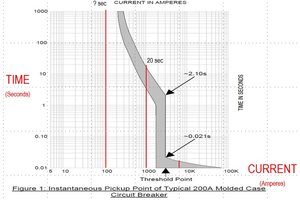| Author |
Message |
|
uriah1
|
Post subject: reduced fault current results in higher incident energy  Posted: Posted: Wed Mar 04, 2015 10:44 am |
|
Joined: Wed Oct 01, 2008 6:05 am
Posts: 27
|
|
In doing a utility data audit, the utility fault current has significantly decreased (from 28kA to 8kA). The downstream incident energy has now increased on the MCC (from 1.2 cal/cm2 to 4.6 cal/cm2). Is this because the arcing current is now less, causing longer trip times, resulting in higher incident energies?
|
|
| Top |
|
 |
|
wbd
|
Post subject: Re: reduced fault current results in higher incident energy  Posted: Posted: Wed Mar 04, 2015 5:44 pm |
|
| Plasma Level |
 |
Joined: Wed May 07, 2008 5:00 pm
Posts: 881
Location: Rutland, VT
|
|
Not sure of what your question is but yes, that is entirely reasonable. You don't state what the voltage is at the MCC but the arcing current is less than the bolted fault current plus if the 85% value is used this will definitely affect the protective device trip time. Plot the TCC and trip time and you will most likely see the increase.
_________________
Barry Donovan, P.E.
www.workplacesafetysolutions.com
|
|
| Top |
|
 |
|
uriah1
|
Post subject: Re: reduced fault current results in higher incident energy  Posted: Posted: Thu Mar 05, 2015 7:35 am |
|
Joined: Wed Oct 01, 2008 6:05 am
Posts: 27
|
|
This is a 480V MCC. Currently it's rated Category 1. With the increased fault current from the utility, this MCC changes to Category 2. I'd like to be able to explain this in simple terms to the maintenance team. An increase in fault current results in slower trip times. Does this suffice? Or is there more detail? Thank you
|
|
| Top |
|
 |
|
AK PE
|
Post subject: Re: reduced fault current results in higher incident energy  Posted: Posted: Thu Mar 05, 2015 9:33 pm |
|
Joined: Tue Mar 03, 2015 8:14 pm
Posts: 4
|
|
Hi Mirah,
The fault current has decreased, not increased.
Please look at the trip device TCC curve and locate where this reduced intersects it.
|
|
| Top |
|
 |
|
uriah1
|
Post subject: Re: reduced fault current results in higher incident energy  Posted: Posted: Fri Mar 06, 2015 7:21 am |
|
Joined: Wed Oct 01, 2008 6:05 am
Posts: 27
|
|
| Top |
|
 |
|
PaulEngr
|
Post subject: Re: reduced fault current results in higher incident energy  Posted: Posted: Sun Mar 08, 2015 7:46 am |
|
| Plasma Level |
 |
Joined: Tue Oct 26, 2010 9:08 am
Posts: 2178
Location: North Carolina
|
|
Changes in fault currents can increase or decrease incident energy. This is a result of how overcurrent protection is affected. For instance if you have an arcing fault current of 10 kA and instantaneous/short term setting of 9 kA, chances are it trips in say 0.065 seconds. If fault current drops to say 8 kA where you only have time overcurrent protection, trip time may jump to say 0.25 seconds. Thus although the arcing power dropped 20%, arcing energy went up by over 300%. In the same scenario of instantaneous/short term was 7 kA, the expected 20% drop does occur. Most of the time carefully watching your arcing fault current and adjusting fast trip settings with respect to that level results in very low incident energy, provided you have enough flexibility in coordination to achieve this. Otherwise the choices are sacrificing coordination, even on a temporary basis (maintenance switches), adding an extra fuse/breaker layer (virtual breaker sometimes), or some of the more exotic gadgets (differential protection, zone interlocking, arc flash relays), assuming the limitation is you cannot adjust low enough and trip times are over about 0.1 s. Below about 0.05 s, arc resistant gear, current limiting or arc terminators are the only good choices.
|
|
| Top |
|
 |
|
BGnan
|
Post subject: Re: reduced fault current results in higher incident energy  Posted: Posted: Sat Apr 18, 2015 1:42 pm |
|
Joined: Tue Nov 04, 2014 5:53 am
Posts: 28
|
|
Keep in mind Energy = Power x time.
Real Electrical Power is equal to Current squared (I^2) times Resistance
The energy released in an arcing event is related to current squared times the arc resistance times the time (duration).
Decreases in the arcing current (related to the fault current per IEEE 1584) can cause the trip point to move from the instantaneous region of a device curve to the short time region thereby increasing the duration of the arcing event by up to 100 x.
Less fault current often results in more incident energy because the impact on trip time is more than the decrease in I squared associated with less fault current.
Energy = I*I*R*t
If the time (duration) increases more than I squared goes down the result is higher incident energy.
See on the attached time current curve where slight changes in fault current below or above 3000A push the trip time by a factor of 100 x.
I am by no means an expert- but this is how I understand and explain the situation to laypeople.
| Attachments: |

revised TCC with notes.jpg [ 109.45 KiB | Viewed 1398 times ]
|
|
|
| Top |
|
 |
 
|
Page 1 of 1
|
[ 7 posts ] |
|
|
You cannot post new topics in this forum
You cannot reply to topics in this forum
You cannot edit your posts in this forum
You cannot delete your posts in this forum
You cannot post attachments in this forum
|
|